JELLYFISH
![[JELLYFISH]](http://www.loststory.net/sites/default/files/quick_tip/jellie75.jpg)
|
Jellyfish are any planktonic marine member of a group of invertebrate animals composed of about 200 described species of the class Scyphozoa (phylum Cnidaria) or of the class Cubozoa, which was formerly considered an order of Scyphozoa. The term, jellyfish, is also often used in referring to certain other cnidarians that have a medusoid (saucer- or bell-shaped) body form, such as hydromedusae, the siphonophores (including even the Portuguese man-of-war which technically is not a jellyfish but a pelagic colonial hydroid or hydrozoan), as well as unrelated forms such as salps and comb jellies.
Seventy of the 200 species of jellyfish are known to sting - causing a range of reactions in humans: from mild skin irritation to death. The sting of the sea wasp, Chironex fleckeri, is so toxic that it can cause death. Some even call this creature the "deadliest animal on earth." Chironex fleckeri is not found in Hawai`i.
The sting of box jellyfish found in Hawai`i, Carybdea alata and Carybdea rastonii, is very painful and can even cause anaphylactic shock in some individuals. 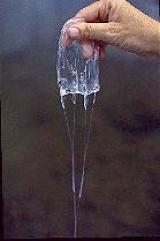 Carybdea alata and Carybdea rastonii, regularly "swarm" to Hawaii's Leeward shores 9 to 10 days after the full moon. Carybdea alata cause the most "trouble" for humans here.
Carybdea alata and Carybdea rastonii, regularly "swarm" to Hawaii's Leeward shores 9 to 10 days after the full moon. Carybdea alata cause the most "trouble" for humans here.
[Tamanaha RH and Izumi AK. Persistent cutaneous hypersensitivity reaction after a Hawaiian box jellyfish sting (Carybdea alata). J Amer Acad Dermatol. 1996 Dec;35(6):991-3.]
There are basically two types of Scyphozoan jellyfish. Those that are free-swimming medusae and those that are sessile (stem animals that attach to seaweed and other objects by a stalk). The order Stauromedusae constitute the sessile polyplike forms. The free-swimming medusoid types, especially the Portuguese man-of-war, are the common, dangerous ones in Hawaiian waters.
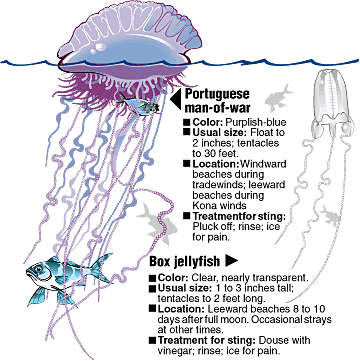
Free-swimming Scyphozoan medusae jellyfish occur in all oceans and include the commonly familiar disk shaped animals that are often found floating along the shoreline. The bodies of most range in diameter from about 1 to 16 inches (2 to 40 centimeters); however, some species are considerably larger with diameters of up to 6 1/2 feet (2 meters). The bulk of the Scyphozoan medusae jellyfish consists of almost ninety-nine percent water as a result of the composition of the jelly that forms the bulk in nearly all species.
Like their close relatives, sea anemones and corals, jellyfish have no head, no heart and no skeleton. Jellyfish don't have brains - because their bodies are organized differently from ours. Most animals we encounter have what's called bilateral - or two-sided - symmetry. They have a head end and a tail end. In the head end, they have a concentration of nerve cells -- where these cells are complex, we call it a brain.
The box jellyfish, Tripedalia cystophora, a cubozoan, is a bizarre, highly poisonous predator . "These are fantastic creatures with 24 eyes, four parallel brains and 60 arseholes," says Dan Nilsson, a vision expert from the University of Lund in Sweden. (Source: New Scientist, 8 November 2003, p. 34)
The eyes occur in clusters on the four sides of the cube-like body. Sixteen are simply pits of light-sensitive pigment, but one pair in each cluster is surprisingly complex, with a sophisticated lens, retina, iris and cornea, all in an eye only 0.1 millimetres across.
The lens structure is unusual because the refractive index - the extent to which it bends light - is graded from one side to the other. Because the image is focused way behind the retina, it appears blurry. So cubozoan eyes are good for spotting large, stationary objects, while filtering out unnecessary detail such as plankton drifting with the current. (Source: New Scientist magazine, 14 May 2005, p. 18)
Most jellyfish feed on small animals that they catch in their tentacles' stinging cells (nematocysts). Others simply filter feed, extracting minute animals and plants (i. e., plankton and nekton, loosened benthos) from the ocean water as they drift. Like all cnidarians, their bodies are made up of two cellular layers, the ectoderm and the endoderm. Between these dermal layers lies the mesoglea, a layer of connective tissue composed of a gelatinous substance, the jelly. In jellyfish the mesoglea is much enlarged to form the buoyant, transparent jelly. Most live for only a few weeks, although some are known to survive a year or longer.
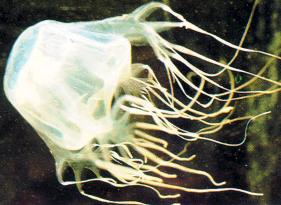 Sea Wasps - box jellyfish that are lethal - the class Cubozoa, order Cubomedusae, family Chirodropidae, genera Chironex and Chiropsalmus, occur widely from Queensland, Australia (from Exmouth in Western Australia to Gladstone in Queensland from November to May) northward to about Malaya. These forms, with a toxin with an LD 50 of 40 micrograms/kg are dangerously venomous. Even a moderate sting can cause death within a few minutes and has a reported mortality of 20% with deaths occuring secondary to respiratory paralysis, neuromuscular paralysis drowning, and cardiovascular collapse. An antivenin, available from Commonwealth Serum Laboratory of Melbourne, Australia, specific for Chironex fleckeri is indicated for all serious envenomations. (The intravenous dose is one ampule over five minutes or the intramuscular dose is three ampules.) Fortunately, these type of jellies are not prevalent or indigenous to Hawaiian waters.
Sea Wasps - box jellyfish that are lethal - the class Cubozoa, order Cubomedusae, family Chirodropidae, genera Chironex and Chiropsalmus, occur widely from Queensland, Australia (from Exmouth in Western Australia to Gladstone in Queensland from November to May) northward to about Malaya. These forms, with a toxin with an LD 50 of 40 micrograms/kg are dangerously venomous. Even a moderate sting can cause death within a few minutes and has a reported mortality of 20% with deaths occuring secondary to respiratory paralysis, neuromuscular paralysis drowning, and cardiovascular collapse. An antivenin, available from Commonwealth Serum Laboratory of Melbourne, Australia, specific for Chironex fleckeri is indicated for all serious envenomations. (The intravenous dose is one ampule over five minutes or the intramuscular dose is three ampules.) Fortunately, these type of jellies are not prevalent or indigenous to Hawaiian waters.
Jellyfish are very common in all water bodies. Do not go into areas where they are sighted, or if dead ones are seen on the beach. Their primary injury mechanism is their tentacles' stinging cells (nematocysts). Symptoms include stinging, burning sensation, vivid redness in the affected areas, swelling of lymph nodes. There may be severe reaction: difficulty with breathing and even cardiac arrest. Visible manifestations include long red welt lines.
First Aid Treatment: Douse or spray liberally with vinegar. Pluck off any visible tentacles carefully - try not to use your fingers, use your fins, a towel, etc. instead to brush them away. For severe pain, try applying a hot pack. If heat makes the sting feel worse, try applying a cold pack or ice to the sting. Get medical help for severe reactions. 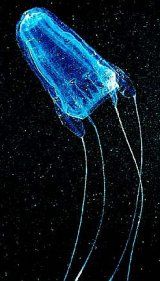 IMMEDIATE MEDICAL ATTENTION MAY BE REQUIRED as their stinging may bring about anaphylactic shock.
IMMEDIATE MEDICAL ATTENTION MAY BE REQUIRED as their stinging may bring about anaphylactic shock.
Box jellyfish, Carybdea alata and Carybdea rastonii, regularly swarm to Hawaii's Leeward shores 9 to 10 days after the full moon. Affected areas include Waikiki Beach, Ala Moana Beach Park, as well as Hanauma Bay, and may also include ocean areas and beach front up to and including the Wai`anae Coast.
We routinely notify the media when we anticipate or observe large "swarms" - the press has been very cooperative in airing and printing these notices. 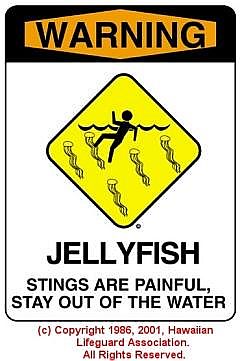 Guarded beaches on O`ahu are posted with special signs by lifeguards when there are jellyfish or portuguese man-of-wars swarming in the surrounding ocean. Observe these signs, stay out of the water, to avoid being stung - a very painful, perhaps even potentially deadly experience.
Guarded beaches on O`ahu are posted with special signs by lifeguards when there are jellyfish or portuguese man-of-wars swarming in the surrounding ocean. Observe these signs, stay out of the water, to avoid being stung - a very painful, perhaps even potentially deadly experience.
Don't touch this animal, especially its tentacles - even when beached and dead. The toxin of the nematocysts remains potent for an extended period of time. Curious keiki (children) will want to play and poke them - keep children far away from these potentially, excruciatingly painful creatures.
If you are stung at a guarded beach see the lifeguards on duty. They can render minor first-aid, or, for more serious cases, call and radio for emergency ambulance or MEDEVAC (helicopter medical evacuation) assistance.
The beaches on Oahu's East shore, commonly referred to as the Windward coast, are infamous for the presence of the portuguese man-of-war (Physalia spp.) jellies. This shore's nearly constant inshore wind blows these painfully stinging creatures close towards the shore. Be well forewarned; observe posted signs and please pay attention to media alerts and warnings.
Links We Like: Emedicine.com has a thorough monograph, web page on Coelenterate and Jellyfish Envenomations that's worth a visit - if you're so inclined, please click here to go there. Be sure to read Dr. Carol Hopper's marine life profile of Carybdea spp. and other interesting Cnidarians and sea creatures at the Waikiki Aquarium's marine life web page.
Please also see our portuguese man-of-war web page.
Suggested Bibliography
Brusca, R. C., G. J. Brusca. Invertebrates. Sinauer Associates, Sunderland, MA (1990).
Burnett, W.J., Williamson, J.A., Fenner P.J. Box jellyfish in Waikiki. Hawaii Medical Journal 2001: 60(11); 278.
Chung J.J., Ratnapala L.A., Cooke I.M., Yanagihara A.A. Partial purification and characterization of a hemolysin (CAH) from Hawaiian box jellyfish (Carybdea alata) venom. Toxicon 2001: 39; 981-990.
Fenner, P. J., Williamson, J. A. Worldwide deaths and severe envenomation from jellyfish stings. The Medical Journal of Australia 1996: 165; 658.
Hamner, W. M., Jones, M. S., Hamner P. P. Swimming, feeding, circulation and vision in the Australian box jellyfish, Chironex fleckeri (Cnidaria, Cubozoa). Marine and Freshwater Research 1995: 46 (7); 985-990.
Hartwick, R. F. Distributional ecology and behaviour of the early life stages of the box-jellyfish Chironex fleckeri. Hydrobiologia 1991: 216/217; 181-188.
Hickman, C.P., L. S. Roberts. Animal Diversity. Wm. C. Brown, Dubuque, IA (1994).
Kaestner, A. Invertebrate Zoology. Interscience Publishers, (1964).
Nagai H., Takuwa K., Nakao M., Sakamoto B., Crow G., Nakajima T. Isolation and characterization of a novel protein toxin from the Hawaiian box jellyfish (Sea Wasp) Carybdea alata. Biomedical and Biophysical Research Communications 2000: 275; 589-594.
Nagai H., Takuwa K., Nakao M., Ito E., Miyake M., Noda M., Nakajima T. Novel proteinaceous toxins from the box jellyfish (Sea Wasp) Carybdea rastoni. Biomedical and Biophysical Research Communications 2000: 275; 582-588.
Shelton, G.A.B. Electrical Conduction and Behaviour in Simple Invertebrates. Claredon Press, Oxford (1982).
Thomas C.S., Scott S.A., Galanis D.J., Goto R.S. Box jellyfish (Carybdea alata) in Waikiki. The analgesic effect of sting-aid, Adolph's meat tenderizer and fresh water on their stings: a double-blinded, randomized, placebo-controlled clinical trial. Hawaii Medical Journal 2001: 60(8); 205-7, 210.
Thomas C.S., Scott S.A., Galanis D.J., Goto R.S. Box jellyfish (Carybdea alata) in Waikiki: their influx cycle plus the analgesic effect of hot and cold packs on their stings to swimmers at the beach: a randomized, placebo-controlled, clinical trial. Hawaii Medical Journal 2001: 60(4); 100-7.
Williamson, J., Fenner, P.J., Burnett J.W., Rifkin, J.R., editors. Venomous and Poisonous Marine Animals. A Medical and Biological Handbook. University of South Wales Press, Sydney (1996).
